Global Climate Change impacts in the world
Tarun M. Pate1 * , A.M. Patel1 and Deepak kardile1
1
Shree M.R.Arts and Science College,
Rajpipla,
Gujarat
India
DOI: http://dx.doi.org/10.12944/CWE.6.2.03
During the twentieth century, the earth’,s surface warmed by about 1.5 °F. There are a variety of potential causes for global climate change, including both natural and human-induced mechanisms. Science has made great strides recently in determining which potential causes are actually responsible for the climate change that occurred during the twentieth century, providing strong evidence that greenhouse gases released to atmosphere by human activities are one of the main causes of contemporary global warming. The paper deliberates to deal with some of the others as well.
Copy the following to cite this article:
Patel TM, Patel AM, Kardile D. Global Climate Change Impacts in the World. Curr World Environ 2011;6:217-223 DOI:http://dx.doi.org/10.12944/CWE.6.2.03
Copy the following to cite this URL:
Patel TM, Patel AM, Kardile D. Global Climate Change Impacts in the World. Curr World Environ 2011;6:217-223. Curr World Environ [serial online] 2011;6:217-223. Available from: http://www.cwejournal.org/?p=233
Download article (pdf)
Citation Manager
Publish History
Select type of program for download
| Endnote EndNote format (Mac & Win) | |
| Reference Manager Ris format (Win only) | |
| Procite Ris format (Win only) | |
| Medlars Format | |
| RefWorks Format RefWorks format (Mac & Win) | |
| BibTex Format BibTex format (Mac & Win) |
Article Publishing History
| Received: | 2011-11-10 |
|---|---|
| Accepted: | 2011-12-15 |
Introduction
Recent decades have seen record-high average global surface temperatures. Thermometer readings sufficient to provide reliable global averages are available back to 1850 (Brohan et al. 2006). In the past century, global surface temperature increased by about 1.5 °F (Figure 1). In the past quarter-century, according to satellite measurements, the lower atmosphere warmed by 0.22-0.34 °F per decade, equivalent to 2-3 °F per century. (Christy and Spencer 2005; Mears and Wentz 2005). The past 20 years include the 18 warmest years on record. (Hadley Centre 2005). This well-documented warming trend could result from several factors that influence the earth’s climate, some of which are natural, such as changes in solar radiation and volcanic activity. Others, particularly the release of certain gases to the atmosphere and land-cover changes, are anthropogenic.
Global climate varies over time in response to climate forcings-physical factors external to the climate system that force a net increase (positive forcing) or net decrease (negative forcing) of heat in the climate system as a whole. (Hansen, Sato et al. 2005). This type of change is distinct from internal climate variability, in which heat is transported by winds or ocean currents between different components of the climate system with no net change in the total heat within the system. The El Ninl-Southern Oscillation is a well- known example of internal climate variability. Because the observed climate change over the twentieth century results from a net increase of heat in the entire climate system, it can only be explained by external forcing. (Hansen, Nazarenko et al. 2005). Hence, the task for climate change scientists is to identify one or more external forcing(s), natural or man-made that can explain the observed warming.
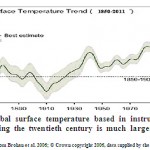 |
Figure 1: Average global surface temperature based in instrumental measurements. Temperature rise during the twentieth century is much larger than the uncertainty range. Click here to View figure |
Defining Weather and Climate
Weather is the state of the atmosphere at a specific time in a specific place. Temperature, cloudiness, humidity, precipitation, and winds are examples of weather elements. Thunderstorms, tornadoes, and monsoons are also part of the weather of some places during some seasons. Climate is defined as long-term weather patterns that describe a region. For example, the New York metropolitan region’s climae is temperate, with rain evenly distributed throughout the year, cold winters, and hot summers.
Causes of Climate Change
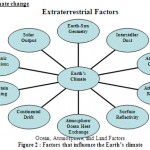 |
Figure 2: Factors that influence the Earth’s climate |
Climate Variability and Climate Change
Climate variability refers to variations in the prevailing state of the climate on all temporal and spatial scales beyond that of individual weather events. Variability may be due to natural internal processes within the climate system, or to variations in natural or anthropogenic (human-driven) external forcing. Global climate change indicates a change in either the mean state of the climate or in its variability, persisting for several decades or longer. This includes changes in average weather conditions on earth, such as a change in average global temperature, as well as changes in how frequently regions experience heat waves, droughts, floods, storms, and other extreme weather. It is important to note that changes in individual weather events will potentially contribute substantially to changes in climate variability. Climate change could occur naturally as a result of a change in the sun’s energy or Earth’s orbital cycle (natural climate forcing), or it could occur as a result of persistent anthropogenic forcing, such as the addition of greenhouse gases, sulphate aerosols, or black carbon to the atmosphere, or through land-use change.
Figure 2 illustrates the basic components that influence the state of the Earth’s climatic system. Changes in the state of this system can occur externally ( from extraterrestrial systems) or internally (from ocean, atmosphere and land systems) through any one of the described components. For example, an external change may involve a variation in the Sun’s output which would externally vary the amount of solar radiation received by the Earth’s atmosphere and surface. Internal variations in the Earth’s climatic system may be caused by changes in the concentrations of atmospheric gases, mountain building, volcanic activity, and changes in surface or atmospheric albedo.
The work of climatologists has found evidence to suggest that only a limited number of factors are primarily responsible for most of the past episodes of climate change on the Earth. These factors include:
- Volcanic eruptions
- Atmospheric carbon dioxide variations
- Variations in solar output.
Volcanic Eruptions
For many years, climatologists have noticed a connection between large explosive volcanic eruptions and short term climatic change. For example, one of the coldest years in the last two centuries occurred the year following the Tambora volcanic eruption in 1815. Accounts of very cold weather were documented in the year following this eruption in a number of regions across the planet. Several other major volcanic events also show a pattern of cooler global temperatures lasting 1 to 3 years after their eruption. At first, scientists thought that the dust emitted into the atmosphere from large volcanic eruptions was responsible for the cooling by partially blocking the tranamission of solar radiation to the Earth’s surface.
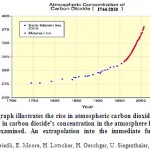 |
Figure 3: The above graph illustrates the rise in atmospheric carbon dioxide from 1744 to 2005. Note that the increase in carbon dioside’s concentration in the atmosphere has been exponential during the period examined. An extrapolation into the immediate future would suggest continued increases Click here to View figure |
However, measurements indicate that most of the dust thrown in the atmosphere returned to the Earth’s surface within six months. Recent stratospheric data suggests that large explosive volcanic eruptions also eject large quantities of sulphur dioxide gas which remains in the atmosphere for as long as three years. Atmospheric chemists have determined that the ejected sulphur dioxide gas reacts with water vapour commonly found in the stratosphere to from a dense optically bright haze layer that redues the atmospheric transmission of some of the Sun’s incoming radiation.
In the last century, two significant climate modifying eruptions have occurred. El chichon in Mexico erupted in April of 1982, and Mount Pinatubo went off in the Philippines during June, 1991. Of these two volcanic events, Mount Pinatubo had a greater effect on the Earth’s climate and ejected about 20 million tons of sulphur dioxide into the stratosphere. Researchers believe that the Pinatubo eruption was primarily responsible for the 0.8 degree Celsius drop in global average air temperature in 1992. The global climatic effects of the eruption of Mount Pinatubo are believed to have peaked in late 1993. Satellite data confirmed the connection between the Mount Pinatubo eruption and the global temperature decrease in 1992 and 1993. The satellite data indicated that the sulphur dixide plume from the eruption caused a several percent increase in the amount of sunlight reflected by the Earth’s atmosphere back to space causing the surface of the planet to cool.
Atmospheric Carbon Dioxide Variations
Studies of long term climate change have discovered a connection between the concentrations of carbon dioxide in the atmosphere and mean global temperature. Carbon dioxide is one of the more important gases responsible for the greenhouse effect. Certain atmospheric gases, like carbon dioxide, water vapour and methane,are able to alter the energy balance of the Earth by being able to absorb longwave radiation emitted from the Earth’s surface. The net result of this process and the re-emission of longwave back to the Earth’s surface increases the quantity of heat energy in the Earth’s climatic system. Without the greenhouse effect, the average global temperature of the Earth would be a cold-18° celsius rather than the present 15° celsius.
Researchers of the 1970’s CLIMAP project found strong evidence in deep-ocean sediments of variations in the Earth’s globlal temperature during the past several hundred thousand years of the Earth’s history. Other subsequent studies have confirmed these findings and have discovered that these temperature variations were closely correlated to the concentration of carbon dioxide in the atmosphere and variations in solar radiation received by the planet as controlled by the Milankovich cycles. Measurements indicated that atmospheric carbon dioxide levels were about 30%lower during colder glacial periods.
It was also theorized that the oceans were a major store of carbon dioxide and that they controlled the movement of this gas to and from the atmosphere. The amount of carbon dioxide that can be held in oceans is a function of temperature. Carbon dioxide is released from the oceans when global temperatures become warmer and diffuses into the ocean when temperatures are cooler. Initial changes in global temperature were triggered by changes in received solar radiation by the Earth through the milankovitch cycle. The increase in carbon dioxide then amplified the global warming by enhancing the greenhouse effect.
Over the past three centuries, the concentration of carbon dioxide has been increasing in the Earth’s atmosphere because of human influences Human activities like the burning of fossil fuels, conversion of natural prairie to farmland, and deforestation have caused the release of carbon dioxide into the atmosphere. From the early 1700s, carbon dioxide has increased from 280 parts per million to 380 parts per million in 2005. Many scientists believe that higher concentrations of carbon dioxide in the atmosphere will enhance the greenhouse effect making the planet warmer. Scientists believe we are already experiencing global warming due to an enhancement of the greenhouse effect. Most computer climate models suggest that the globe will warm up by 1.5-4.5 celsius if carbon dioxide reaches the predicted level of 600 parts per million by the year 2050.
Variations in Solar Output
Until recently, many scientists thought that the Sun’s output of radiation only varied by a fraction of a percent over many years. However, measurements made by satellites equipped with radiometers in the 1980s and 1990s suggested that the Sun’s energy output may be more variable than was once thought. Measurements made during the early 1980s showed a decrease of 0.1 percent in the total amount of sola energy reaching the Earth over just an 18 month time period. If this trend were to extend over several decades, it could influence global climate. Numerical climatic models predict that a change in solar output of only 1 percent per century would alter the Earth’s average temperature by between 0.5 to 1.0° Celsius. Scientists have long tried to also link sunspots to climatic change. Sunspots are huge magnetic storms that are seen as dark (cooler) areas on the Sun’s surface. The number and size of sunspots show cyclical patterns, reaching amaximum abot every 11, 90, and 180 years. The decrease in solar energy observed in the early 1980s correspond to a period maximum sunspot activity based on the 11 year cycle. In addition, measurements made with a solar telescope from 1976 to 1980 showed that during this period, as the number and size of sunspots increased, the Sun’s surface cooled by about 6 Celsius. Apparently, the sunspots prevented some of the Sun’s energy from leaving its surface. However, these findings tend to contradict observations made on longer times scales. Observations of the sun during the middle of the Little Ice Age(1650 to 1750) indicated that very little sunspot activity was occurring on the Sun’s surface. The Little Ice Age was a time of a much cooler global climate and some scientists correlate this occurrence with a reduction in solar activity over a period of 90 or 180 years. Measurements have shown that these 90 and 180 year cycles influence the amplitude of the 11 year sunspot cycle. It is hypothesized that during times of low amplitude, like the Maunder Minimum, the Sun’s output of radiation is reduced. Observations by astronomers during this period(1645 to1715) noticed very little sunpot activity occurring on the Sun. During periods of maximum sunspot activity, the Sun;s magnetic field is strong. When sunspot activity is low, the Sun’s magnetic field weakens. The magnetic field of the sun also reverses every 22 years, during a sunspot minimum. Some scientists believe that the periodic droughts on the Great Plains of the United States are in some way correlated with this 22 year cycle.
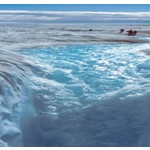 |
Figure 4 Click here to view figure |
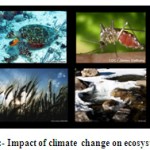 |
Figure 5: Impact of climate change on ecosystems Click here to view figure |
Effects of Climate Change Today
Over 100 years ago, people worldwide began burning more coal and oil for homes, factories, and transportation. Burning these fossil fuels releases carbon dioxide and other greenhouse gases into the atmosphere. These added greenhouses gases have caused Earth to warm quickly than it has in the past.
How much warmng has happened? Scientists from around the world with the Intergovernmental panel on Climate Change (IPCC) tell us that during the past 100 years, theworld’s surface air temperature increased an average of 0.6 Celsius (1.1 F). This may not sound like very much change, but even one degree can affect the Earth. Below are some effects of climate change that we see happening now.
- Sea level is rising: During the 20th century, sea level rose about 15 cm (6 inches) due to melting glacier ice and expansion of warmer seawater. Models predict that sea level may rise as much as 59cm (23 inches) during the 21st Century, threatening coastal communities, wetlands, and coral reefs.
- Arctic sea ice is melting : The summer thickness of sea ice is about half of what it was in 1950. Melting ice may lead to changes in ocean circulation. Plus melting sea ice is speeding up warming in the Arctic.
- Glaciers and permafrost are melting: Over the past 100 years, mountain glaciers in all areas of the world have decreased in size and so has the amount of permafrost in the Arctic. Greenland’s ice sheet is melting faster too.
- Sea-surface temperatures are warming: Warmer waters in the shallow oceans have contributed to the death of about a quarter of the world’s coral reefs in the last few decades. Many of the coral animals died after weakened by bleaching, a process tied to warmed waters.
- Heavier rainfall cause flooding in many regions: Warmer temperatures have led to more intense rainfall events in some areas. This can cause flooding.
- Extreme drought is increasing: Higher temperatures cause a higher rate of evaporation and more drought in some areas of the world.
- Ecosystems are changing: As temperatures warm, species may either move to a cooler habitat or die. Species that are particularly vulnerable include endangered species, coral rees, and polar animals. Warming has also caused changes in the timing of spring events and the length of the growing season.
- Impact of climate change on ecosystems:
- Increased warmth has also affected living things. For example, the Japanese keep very detailed records on the blossoming of their Tokyo cherry trees, so they know they are blooming 5 days earlier on average than they were 50 years ago.
- Also mosquitoes, birds, and insects are moving north in the Northern Hemisphere.
- A warming planet means continuing changes in its ecosystems. As the oceans absorb more carbon dioxide, the chemistry of the ocean changes, putting many sea creatures at risk.
- The increases of 5-20% in crop yields in the first decades of this century. but the crops will be more prone to failure if climate variability increases and precipitation becomes less dependable. And ironically, with higher temperatures comes an increased potential for killing freezes. This is because plants start growing earlier, making them more vulnerable to sudden spring-time cold spells.
- More frequent heat waves: It is likely that heat waves have become more common in more areas of the world.
- Warmer temperatures affect human health: There have been more deaths due to heat waves and more allergy attacks as the pollensean season grows longer. There have also been some changes in the ranges of animals that carry disease like mosquitoes.
- Seawater is becoming more acidic: Carbon dioxide dissolving into the oceans, is making seawater more acidic. There could be impacts on coral reefs and other marine life.
Conclusion
Most of the observed increase in globally averaged temperatures since the mid-20th century is very likely [i.e. greater than 90% certainty] due to the observed increase in anthropogenic greenhouse gas concentrations. This is an advance since the [2001 IPCC report] conclusion that “most of the observed warming over the last 50 years is likely to have been due to the increase in greenhouse gas concentrations”. Discernible human influences now extend to other aspects of climate, including ocean warming, continental-average temperatures, temperature extremes and wind patterns.(IPCC 2010)
References
- J Hansen, L Nazarenko, R Ruedy, MSato, j Willis, A Del Genio, D Koch, A Lacis, K Lo, S Menon, T Novakov, j Perlwitz, G Russell, G A Schmidt, N Tausnev. Science, 2005; 308:1431.
- P Brohan, jj Kennedy, I Haris, S F B Tett, P D jones. Journal of geophysical Research 2006; 111,D12106.
- J R Christy, R W Spencer. Science, 2005; 310:972.






